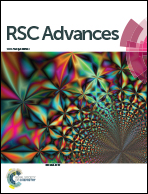The oxidation product (NO3−) of NO pollutant in flue gas used as a nitrogen source to improve microalgal biomass production and CO2 fixation†
Abstract
In order to eliminate the inhibition effect of the toxic nitric oxide (NO) in flue gas on microalgal growth and CO2 fixation, NO was converted by a wet UV/H2O2 method to produce nitrate (NO3−), which then be used as a nitrogen source for microalgae to improve its growth. The growth ability and biomass compositions of the microalgae cultivated with the produced NO3− from NO gas were similar to those of the microalgae cultivated with equivalent moles of commercial NaNO3. The NO3− concentration produced from NO increased with UV lamp power, H2O2, and NO concentrations, resulting in an improved microalgal growth. The concentration of NO3− from 500 ppm NO wet-oxidized by 6% (v/v) H2O2 and 55 W UV light was up to 8.8 mM. When the produced nitrate was used as supplementary nitrogen source, the maximum growth productivity of Chlorella PY-ZU1 at 15% (v/v) CO2 reached 1.18 g L−1 per day (0.97 times higher than that cultivated with the standard medium). The peak fixation efficiency of 15% (v/v) CO2 was 69.6% (1.13 times higher than that cultivated with the standard medium).


 Please wait while we load your content...
Please wait while we load your content...